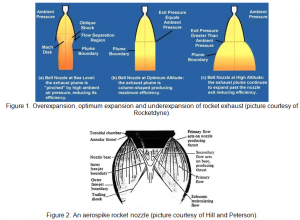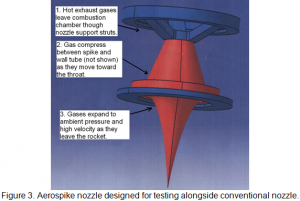Jeffrey L. Smith and Dr. Paul F. Eastman, Mechanical Engineering
Abstract
Safe, reliable, technologies are needed to launch a new generation of astronauts and space tourists into space. The aerospike nozzle is more efficient than traditional bell shaped nozzles and is safer because of lower combustion chamber pressure. These excellent performance characteristics have never before been tested in conjunction with a hybrid rocket motor. This paper presents the design and testing method for an aerospike rocket.
Introduction
Traditional rocket motors use bell shaped nozzles to expand hot, high pressure combustion gases to ambient pressure and velocity, producing the thrust necessary to propel the rocket. These nozzles are designed to expand the combustion gases to one specific pressure, which occurs naturally at only one altitude along its trajectory. The resulting overexpansion or underexpansion of exhaust gases reduces the efficiency of the motor (see figure 1). Aerospike motors are designed to expand to the optimal pressure at all altitudes along the flight trajectory, producing higher levels of thrust during the entire flight (see figure 2).

Design
Using the same method utilized by Besnard1, an aerospike nozzle was designed for the ARES hybrid sounding rocket at BYU (see figure 3). This nozzle is capable of 2500lbf thrust at a design altitude of 10,000 feet. This rocket was scheduled to be launched in October 2006 at Dugway Proving Grounds, but due to scheduling conflicts the launch has been postponed.

Future Work
Due to the unavailability of a large hybrid rocket capable of flying repeated flights, the flight testing will instead be run on the commercially available R.A.T.T Works I90 hybrid rocket motor (see figure 4). The motor will be modified to accept both conventional and aerospike nozzles with the same expansion ratio and throat area. Using a k-factorial statistic test, the performance of the aerospike nozzle will be compared to the control (conventional) nozzle to find if a statistically significant difference in maximum altitude can be achieved with the aerospike nozzle.

References
- E. Besnard, H Chen, T. Mueller, “Design, Manufactureing and Test of a Plug Nozzle Rocket Engine,” AIAA Paper No. 2002-4038, 2002.
- E. Besnard and J. Garvey, “Development and Flight-Testing of Liquid Propellant Aerospike Engines,” AIAA Paper No. 2004-3354, 2004.
- T. Bui et al., “flight Research of an Aerospike Nozzle Using High Power Solid Rockets,” AIAA Paper No. 2005-3797, 2005.
